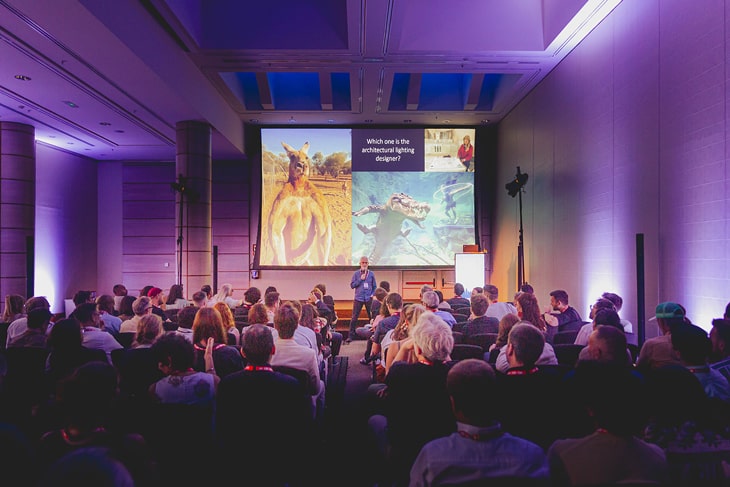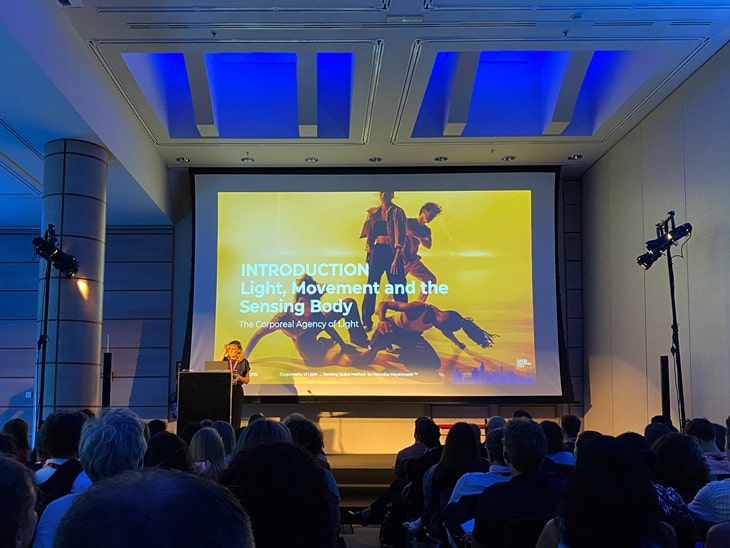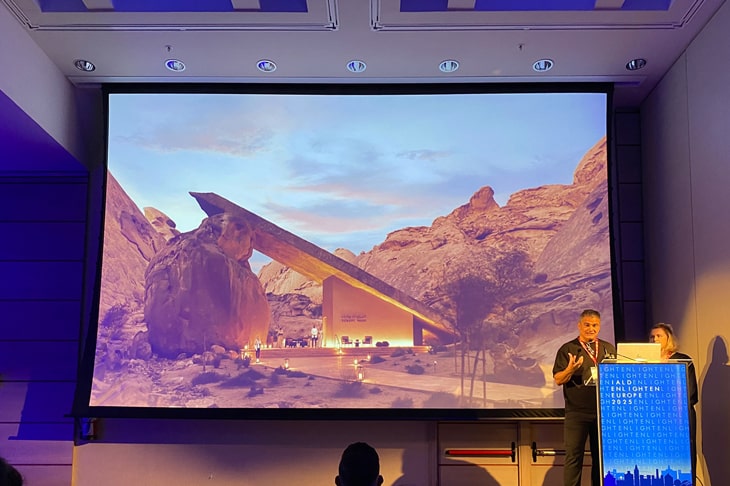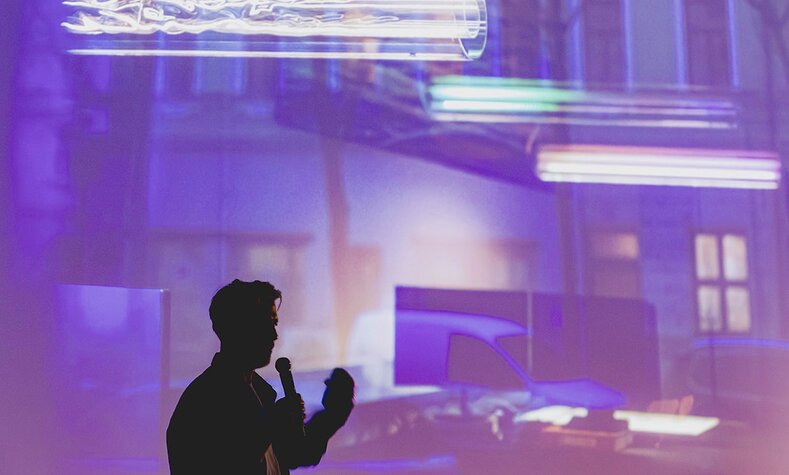From 25 to 27 June, we attended an IALD Enlighten Conference for the first time and are very pleased to have joined the IALD community as new members. We want to better understand the topics that matter most to lighting designers and engineers—specifically, what inspires their work and the issues they face in their profession. And like DIALux, the IALD is active worldwide, which gives us an overview of the lighting profession that is not limited to Europe.
In Valencia, we encountered a highly engaged community of professionals, actively addressing challenges related to technological advancement, climate change, and evolving cultural shifts. What particularly impressed us was the contagious passion they have for their craft, combined with thoughtful reflection on the future of the lighting profession.
These three days continue to resonate deeply with us: it was an incredible experience to immerse ourselves in the inspiring, energetic atmosphere of the IALD community. We met many wonderful people and were thoroughly impressed by the outstanding quality of the talks and discussions. Here is a brief overview for everyone who could not join us in Valencia.
Light and Urban Life
In his talk, Gary Thornton, Director at the architectural lighting design practice Nulty, demonstrated how carefully planned urban lighting can fulfil functional requirements and actively contribute to the well-being and emotional health of city residents. He provided specific examples of cities where lighting masterplans had been successfully implemented to enhance community spirit, social interaction and mental health.
Virginie Nicolas, a lighting designer at the Paris-based agency Concepto, expanded this approach by sharing insights on protecting urban flora and fauna. She presented detailed research demonstrating the negative impact of artificial night-time lighting on urban trees, and proposed strategies for the sustainable protection of plants in urban environments.
Katja Schiebler and Arne Hülsmann, both from the firm Andres + Partner, supplemented this topic with inspiring case studies demonstrating how reflected daylight, combined with the targeted use of materials and design approaches, can significantly increase both the ecological sustainability and the architectural beauty of urban spaces.

Perception and Philosophy
Kevan Shaw, Design Director at EFLA | Kevan Shaw Lighting Design, invited the audience to join a lively discussion about the perception and reality of light. Through historical and contemporary philosophical approaches, he illustrated how visual perception shapes our understanding of light, proposing the development of a new, contemporary philosophy of light for designers.
Juan Ferrari, Project Director at Hoare Lea, picked up on this idea, connecting lighting design with Plato's philosophy of time and eternity. Through different case studies, he showed how deliberate lighting design can make time perceptible and give spaces deeper meaning. Clementine Fletcher-Smith, a Partner at Speirs Major Light Architecture, contributed to the debate by suggesting that light could appear 'heavy'. She impressively demonstrated through projects how light created an emotional and psychological presence that decisively altered the impact of architecture.

Technology and Innovation
Foad Shafighi, Senior Lighting Designer at HGA, excited the audience by providing practical insights into AI tools that can transform the workflow of lighting designers. He showed how AI-driven systems support and accelerate design processes by taking over tasks such as research and concept visualization, creating more time for creativity.
James Simpson, Director at Cooper Candle, opened the audience’s eyes to the future of lighting design in virtual worlds, particularly in the Metaverse. Using captivating examples from virtual projects, he showed how advanced gaming technologies such as Unreal Engine open up new, limitless design possibilities.
Mark Lloyd, technologist and leader and investor in the Gillard Group, challenged the audience with a thought-provoking outlook on current technological developments, urging lighting designers to redefine their roles and seize innovative business opportunities. “Think about light. Not about lighting.”

Health and Human-Centered Design
Willie Duggan, the Managing Director of Willie Duggan Lighting, passionately advocated for a reorientation of lighting design that considers health aspects more strongly, particularly circadian rhythms and the long-term effects of artificial light. He presented convincing scientific data demonstrating the crucial role of correct lighting in health.
Flick Ansell, Associate Director at AECOM, complemented this approach by presenting significant research findings on lighting design for neurodiverse user groups. Ansell vividly demonstrated how specific lighting conditions can improve behavior and well-being for both neurodivergent and neurotypical individuals.
Dr. Shelley James, 'The Light Lady', further explored this field by revealing the fascinating connection between neuroarchitecture and intelligent lighting design. Her practical examples showed how light can be used to create spaces that promote mental clarity, concentration and emotional balance.
Veronika Mayerböck, a lighting designer and architect from Vienna, contributed to the discussion by offering an innovative perspective on the perception and bodily experience of light. Using her 'Sensing Space' concept, she explained how holistic, body-oriented perception influences the design of lighting solutions. Through inspiring examples from her teaching projects, she showed how lighting design engages the whole body, not just the sense of sight, opening up new possibilities for holistic and empathetic design processes.

Creativity and Practice in Lighting Design
Lisa Dukić, lighting designer from Austria, took listeners on an exciting journey into the world of theatrical lighting, vividly demonstrating how creative theatre techniques could be transferred to architectural lighting. She illustrated this with numerous examples, showing how colour, shadows, patterns and dynamic controls could create atmospheres and tell emotional stories in architectural spaces.
Till Armbrüster and Sebastian Hepting further explored this topic, demonstrating how dynamic and coloured lighting can subtly and sustainably alter spatial perception. Their examples ranged from simple, poetic solutions to complex, technologically sophisticated installations.
Ziad Fattouh, Managing Partner at Delta Lighting Design, and Erin Denkovska, Senior Associate at the same firm, presented a playful and experimental approach that was highly inspiring. They convincingly demonstrated that embracing mistakes and creative experimentation is essential for developing innovative and surprising lighting solutions that go far beyond conventional practices. And they showed stunning projects revealing a profound level of care for atmosphere and lighting quality.
(Title image © IALD; Photography by Santiago Vidal, VISUUA.)

